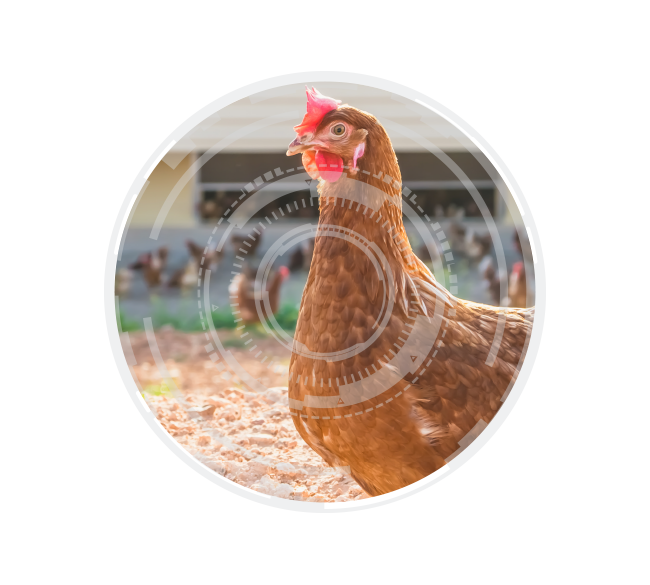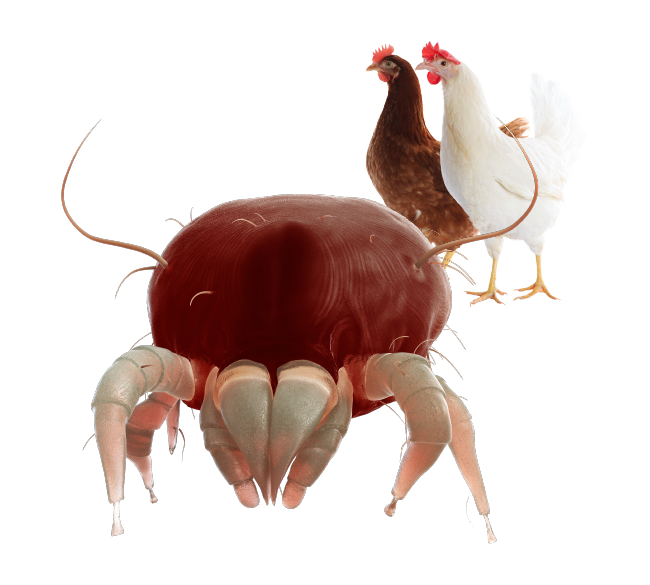Abstract
Animal welfare has become a major issue of poultry production in industrial countries. Government authorities, NGOs, retailers and consumers raise concern about intensive livestock production systems, in particular those used for egg production. The main points of concern of conventional cages are the restricted space and lack of structural elements, such as litter, nests and perches to perform natural behaviours. There is a strong movement to replace conventional cages by more spacious and structured furnished cages, barns, or aviaries with or without access to winter garden or free range. Large groups and the behaviour of free moving hens in alternative systems represent particular challenges for the egg producers and poultry breeders. Good nesting behaviour is required to reduce the number of floor eggs. Fear and sudden outbreaks of panic or nervousness in large groups in cage free systems not only lead to reduced performance but also increase mortality through suffocation of hens in corners in the litter area and nest. Damages of feather pecking and cannibalism can be exacerbated in large groups as is the case in alternative systems. Further welfare problems in layer strains are molting of hens by using feed restriction and culling day-old male chicks of layer lines. Conventional methods to molt layers based on withdrawal of feed, water and light have been phased out in many countries and are being replaced by non-fasting methods. Moreover, molting may become obsolete thanks to selection for persistent egg production and stronger eggshell quality, which allows extended laying periods in practice. There is a strong opposition in some countries against culling day-old male chicks of layer lines. Rearing the male chicks up to slaughter weight or using dual purpose breeds and sex determination in-ovo are being investigated and tested at present as alternatives.
Keywords:
Laying hens, welfare, behavior, fear, smothering, feather pecking, nesting, dual purpose breeds, molt, in-ovo sexing
INTRODUCTION
In the past the consumption of eggs as a valuable source of protein for human nutrition was the privilege of the wealthier part of the human population. The development of high producing genetic lines, intensive husbandry systems and use of balanced compound feed has led to a dramatic reduction of costs and market price for poultry eggs. At the beginning of intensive egg production in the 1950ies, the price for 6 eggs was the equivalent of an hourly wage rate. Today more than 150 eggs can be bought for a one-hour wage. Eggs, as an excellent protein source, have become affordable for all social groups in industrialized countries. The decrease in production costs is mainly based on genetic progress, prevention of diseases and keeping large populations under specialized housing systems. These developments have improved not only the productivity, liveability and efficiency of the birds; but also the eco-footprints, such as emission of greenhouse gases and ammonia, and improved the utilization of scarce raw materials, energy and water (Flachowsky, 1992; Dekker et al., 2012, Pelletier et al., 2014). The key parameter of the simultaneous improvement of economic and environmental criteria is the change in feed efficiency. While more than 3 kg of feed was required to produce 1 kg of egg mass in the 1950ies (Roemer 1953), the feed : egg conversion ratio has decreased to less than 2 : 1 at present. Intensive keeping of farm animals and laying hens in particular, has been subject to reservation in industrial countries (Bessei 2018). Indeed, the caged laying hen has been used as a symbol of animal suffering (Dawkins, 1980). The reasons for this response are manifold. One of the most important aspects was the rapid transition from the family flock in the unlimited free-range system to the intensive deep litter system and cages. This development occurred in Europe between the 1950ies and 1970ies and helped to improve the health status of the flocks and better control of the environment which had a positive effect on the productivity and liveability of the birds. Furthermore, it allowed high automatization of egg production and reduced the workload for the farmers. The view of the traditional free-range system, however, persisted in the memory of the urban population and has been often idealized (Figure 1). Scientists, mainly in Northern European countries, expressed their concern about the extremely restricted space allowance and the lack of nests, perches and litter (Blokhuis et al., 2007). 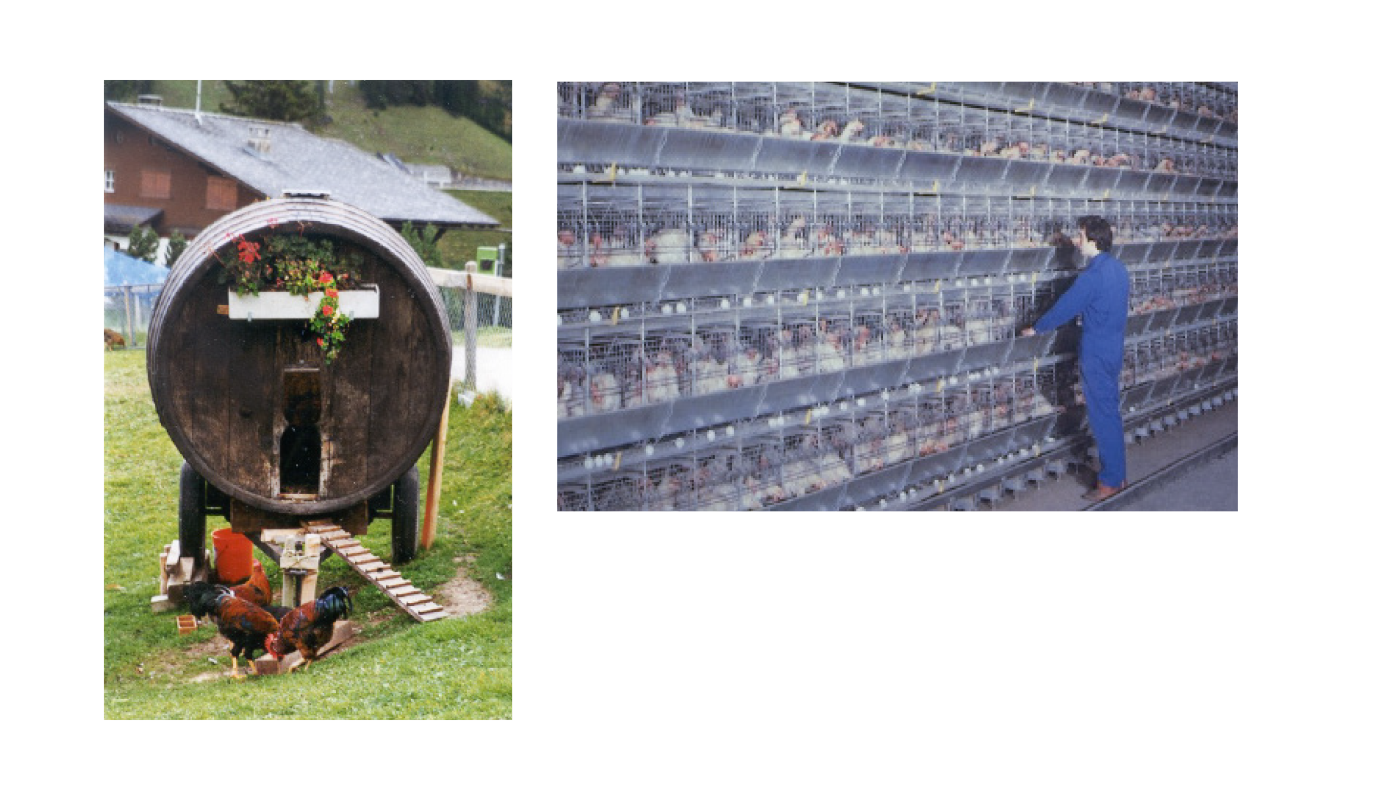
Consequently, conventional cages were banned in the EU as of 2012. In some countries, like Switzerland, Finland and Sweden conventional cages were banned even before that time. Resistance against caging of laying hens has emerged with some delay in North America and in Australia and attempts to introduce “cage-free” systems is gaining momentum continuously (Windhorst, 2016). In the USA, California formulated minimum requirements for laying hens in a way that bans conventional cages. Other states established similar regulations (Vizzier-Thaxton et al., 2016). In the meantime, retailer and restaurant chains in the US and Canada announced a stop of eggs produced in conventional cages in favour of cage-free eggs in the short or medium term. It has been estimated that 50 percent of the eggs in these two countries will be produced in alternative systems, such as barns, aviaries and free range within the next five years. With the transition from cages to cage-free systems, the hens can enjoy more freedom to move and express locomotor activity, scratching and dustbathing, nesting and perching behavior. With the relatively new non-cage systems new issues are arising, which must be considered carefully. Management has to be adapted accordingly and birds must be reared in systems that are similar to the system that the birds will find in production. Birds need to learn to fly and to move appropriately in the system to find water and feed. More labour and time is needed to monitor the bird behaviour and take appropriate actions if needed. From a breeding point of view, in addition to conventional selection criteria like egg production, feed conversion and egg quality, traits related to animal welfare have become more specific weight in the selection index in the last decade. Special testing performance under alternative systems have been developed to collect this information (Icken et al., 2012; 2013a). Besides new regulations and new challenges related to housing systems, the egg industry is facing other critical arguments against common practices, such as the procedure of beak treatment, molting and culling of day-old male chicks of layer strains. In the following text we will present the state of knowledge on the above-mentioned welfare topics.
Welfare problems related to management systems
Obviously, birds in modern alternative systems benefit from more space, physical activity and the ability to express natural behaviour. However, in the non-cage systems laying hens are facing other problems, which compromise their welfare and need to be addressed by egg producers and layer breeders.
FEAR, NERVOUSNESS AND SMOTHERING
Nervousness and repeated episodes of vigorous flight reactions (hysteria) have been reported as a widespread problem if layers are kept in large colony cages or on slatted floor without litter. Hysteria is characterized by a sudden increase in vocalization (squawking), flying around and running (streaming) without obvious reason and attempts to hide in a corner or underneath the feeders and drinkers. Strain, large group size and high stocking density have been identified as influencing factors (Hansen, 1976). Hysteria caused reduced egg production, damages of the feathers and wounds from scratches. Hysteric episodes of smothering also lead to high mortality when the flock is piling up in a corner of the pen after a vigorous flight. Reducing group size and stocking density and the provision of structure elements, such as litter, perches and divisions of the space have been found to reduce the risk of outbreaks. Furthermore, music and to go through the flock with different colour clothes and at different hours so that the birds are getting used to new events and starting this already in the rearing can help to reduce nervousness. Another type of smothering of hens may occur in connection with dustbathing and nesting. Chickens have a strong motivation for dustbathing when offered spacious littered areas. Dustbathing is considered as natural behaviour which helps to keep the feather cover in good condition (Widowski and Duncan, 2000; Scholz et al., 2014). It is often observed that large numbers of hens gather in specific parts of the pen for synchronized dustbathing, particularly in the afternoon after oviposition. This can lead to overcrowding and smothering (Odén et al., 2002). Smothering can also occur in the context of oviposition. When searching for a suitable nest site, hens tend to crowd together in particular nest areas, mainly at the end of a nest line. Piling also occurs in connection with floor eggs, when hens lay eggs outside the nest in corners of the littered or slatted areas and attract the attention of group mates. Campbell et al. (2017) reported spontaneous smothering spread over the whole daytime and lasting from 1 minute to 6 hours. The authors observed a dynamic increase and shrinking of the aggregation. Neither the cause of aggregation nor that of the disintegration could be identified. There was no mortality in this case. In a survey on smothering in free-range flocks in the UK egg producers reported that more than 50 percent of their flocks were exhibiting this behaviour (Barret et al., 2014). Time and site of smothering, with exception of smothering in the nests, was unpredictable and highly variable. The mortality was generally low. Rayner et al. (2016) found that breed and nest box type as factors affect smothering in the nests. According to own experience smothering in the nests may lead to high mortality through suffocation and over-heating, especially under hot ambient temperature. Hence smothering is not only an economic but also a serious welfare problem in alternative layer systems. Division of nest rows in small segments and interruption of the perches in front of the nests reduce the risk of crowding in the nests. Further management recommendations to avoid or reduce the incidence of smothering are to generate distraction of the hens through acoustic enrichment, such as playing music or running the feeder chain in the afternoon. In addition, walking more frequently the birds, to avoid corners and spots with higher light intensity, temperature or different ventilation or scattering grain in the litter are reported as means to reduce the problem. Fear has been assumed as influencing factor of the decision of hens to use or to avoid access to free range (Grigor et al., 1995). This has been confirmed in a study of Hartcher et al. (2016). The authors used RFID technology to analyse the use of free range in a layer flock. Hens, which made more visits and spent more time in the free range showed significantly less fear in a Tonic Immobility test. It is generally assumed that panic and smothering is a form of fear response to environmental conditions. Fear in the domestic fowl has been shown to be heritable (Siegel, 1979). There exist tests for fear, such as the Tonic Immobility Test (TI), Open-Field test (OF) and Emerge-Test, which can be easily performed in young chicks and included in the selection programs (Figure 2). Further research is required to demonstrate the effectiveness of these procedures to reduce hysteria and smothering in commercial lines and crosses. Traditionally information from birds housed in family cages has been used to select for calmer birds that show less flightiness. Future technologies that can automatically capture individual behaviour information in a group of birds in a cage-free environment could help to improve these traits. However, an additional effort to adapt the environment and management to avoid these behaviours should be made. 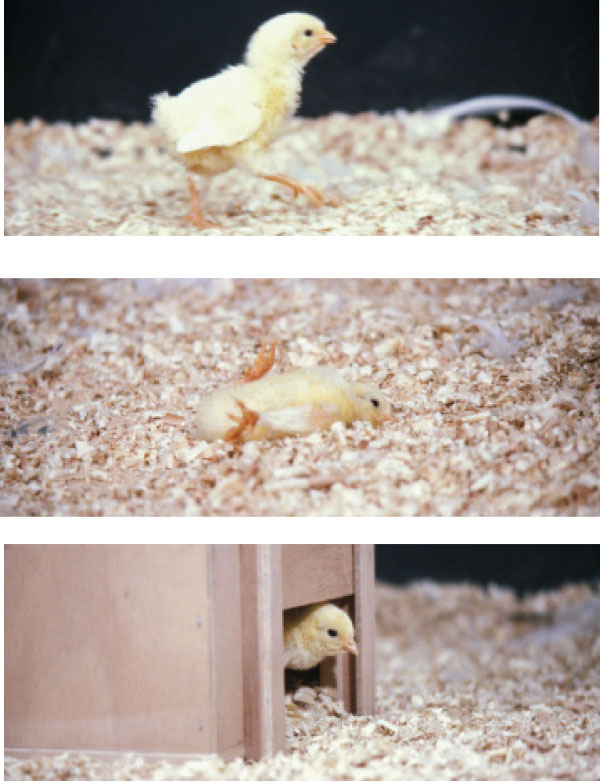
Nesting behaviour
Nesting behaviour was not important as long as hens have been selected and kept in cages, especially for male lines. The female lines needed to have a good nesting behaviour for the parent stock performance already before the cage free era. With the transition from cage to alternative layer systems nesting behaviour of layer lines is gaining momentum. Eggs laid outside the nests are exposed to several challenges. They may become dirty and contaminated when laid in the litter, risk to break when laid on the slat or risk to be eaten. Minimizing floor eggs in commercial flocks requires special management procedures, such as early transfer of pullets to the layer facilities, frequent collection of floor eggs at the start of egg laying, avoiding of dark areas in the litter, facilitation of nest access, sufficient nest space, attractive nest lining. Even if all recommendations known to minimize floor eggs are followed, the problem cannot be solved by management procedures only. Primary poultry breeders have incorporated nesting behaviour and include suitable criteria in their composite selection index in order to adapt commercial strain crosses to non-cage systems. H&N and Lohmann Breeders have recognised this challenge and pedigreed breeding stocks are tested in floor systems in addition to the conventional performance test in cages for more than a decade. The development of the so-called funnel nest allows the identification of eggs of individual hens within flocks kept in pens (Figure 3). The hens are tagged with a RFID tag, which identifies its entrance of the nest (Icken et al., 2012). The attribution of the eggs laid to the individual hen is enabled through special software. Egg production in the transponder nest system allows selection for nesting behaviour and contributes to reduce floor eggs in commercial flocks.
Feather pecking and cannibalism
Damage caused by feather pecking and cannibalism represents serious welfare problems not only in laying hens but also in growing turkeys, Muscovy ducks and other species of fowl. This behaviour can develop in pullets at young age and continue in adults. Phases of intensive feather pecking usually precede cannibalistic pecking. The time of outbreak of feather pecking and cannibalism is unpredictable. Preferred areas of feather pecking are the lower back nearby the pygostyle, the vent and neck. In some cases, cannibalistic pecking at the toes and wing tips occurs without previous severe feather pecking. Cloacal cannibalism or “peck-out” is often related to the eversion of the mucous membrane of the oviduct immediately at oviposition, in some cases as prolapse. Laying outside the nests, or bright light inside the nests make mucous membranes visible to the group mates and thus stimulates cloacal pecking. Once a hen shows bloody spots on any part of the body, she becomes a target for being pursued and pecked by other hens. Thus, the wounded hens will be pecked to death within a few hours if not separated or treated with repellents. The main cause of this behaviour is natural curiosity of hens using their eyesight and beak in search for edible feed. Many factors may contribute to the observed variation of incidence under commercial conditions. Nutrient deficiencies, lack of foraging materials, bright light, group size, stocking density and other risk factors have been identified (Nicol et al., 2013). Recommendations to prevent this damaging behaviour comprise nutritional measures, such as increased levels of essential amino acids, minerals and crude fibre, and management procedures, such as providing hay baskets, pecking blocks or other occupation materials. The most efficient means are reduced light intensity and beak treatment (Flock et al., 2005). Beak treatment does not prevent feather pecking, but reduces damaged feathers, wounds from feather pulling and cannibalism as a result of bleeding wounds. Therefore, cannibalism rarely occurs in beak-treated flocks. Removal of the tip of the beak causes pain and has therefore been criticized by welfare organizations. In some countries (e.g. Switzerland, Sweden, Norway, Finland) this treatment is generally prohibited. In the EU beak treatment as preventive measure against feather pecking and cannibalism is allowed in chicks up to 10 days of age when carried out by competent staff. In some countries (e.g. Germany) beak treatment requires special allowance of the authorities in charge of animal welfare, and various countries announced a future ban of beak trimming. In order to anticipate legal measures against beak treatment German egg producers decided to use intact-beak layers from 2017 onwards. It has been estimated that the use of intact-beak hens increases egg production costs, mainly through poor feathering and cannibalism (Damme and Urselmans, 2013). To control damages in intact beak flocks a more intensive attention form the farmers is required in order to detect and react before this behaviour has been widespread in the flock. Based on a literature review Lambton et al. (2014) designed 46 bespoke management packages and tested them in a large-scale field study. Damages through injurious pecking could be reduced by adoption of the proposed management measures. But injurious pecking remained on a high level. The authors concluded that genetic selection should be used to control the problem. Genetic variation of feather pecking has been found in various studies. Depending on the statistical model used the heritability varied between 0.11 and 0.20 (Bennewitz et al., 2014, Grams et al., 2014). Selection for high and low feather pecking or beak-inflicted injuries has proved to be effective in various selection experiments (Muir and Craig, 1998; Su et al., 2005). View link: http://lohmann-information.com/content/l_i_48_artikel12.pdf While selection for high feather pecking has shown significant responses within a few generations the response was lower in the line selected for low feather pecking, and high feather pecking birds emerged in this line even after 11 generations of intensive selection (Piepho et al., 2017). Commercial breeders however, do not have the tools to collect information on activity, fearfulness and measure feather pecking of individual birds within a group which are applicable in large numbers of breeding stocks and multiple lines at the same time. They rely on correlated traits which can be recorded more easily and with low labour input. One of the strategies is keeping families in small groups and scoring the feather conditions as well as recording mortality. This procedure has proved to be effective and reduced damaging feather pecking to a low level. Additionally, since several years selection for a blunt beak has been incorporated in breeding programs to reduce the negative impact of feather pecking (Icken et al., 2017). Regarding the multi-factorial nature of this behaviour, it was not possible to eliminate it with conventional genetic measures. It is expected that the situation improves when markers for feather pecking are identified in the chicken genome. Research in this direction is currently carried out in different research institutes. However, although some regions and different QTLs have been reported to have a significant effect on feather pecking, it seems to be a polygenic trait influenced by many genes with small effects (Iffland et al., 2020). Using a combination of sensor technology and genomic methods to identify feather peckers and victims in groups could deliver a potential solution in the future (Ellen et al., 2019)
Molt
The traditional method to molt layer flocks through withdrawal of feed, water and light for several days is prohibited in the EU. Chickens must have access to feed and water at any time (EU, 1999). In the USA, molting is not legally prohibited, but according to the welfare regulations of the largest egg producers association UEP fasting hens to introduce a laying pause is not permitted (UEP, 2016). Park et al. (2004) investigated alternatives to feed withdrawal in the USA. “Soft” methods of introducing a laying pause, such as using low-sodium diets (Bessei, 1978) or replacing the compound layer feed through grain only are applied in Germany for more than 30 years (Petersen and Goebel,1996). Using these methods, the birds have access to feed and water. The light period is reduced to a minimum of 8 hours. Since breeding companies select lines continuously for longer laying persistency, molting layers may become obsolete. Nowadays hens can be kept for egg production for more than 90 weeks of age (Flock and Anderson, 2016). The focus is set not only on egg production but also in keeping a good eggshell quality, especially at advanced age. This combination allows extending the productive life of the birds and the total lifetime performance. Furthermore, the number of broken or cracked eggs is reduced with a positive effect on the profitability of the business and on the quality of the product for the consumers.
Culling day-old males of layer lines
It is generally known that egg production and weight gain in chickens are negatively correlated. This was the reason for the development in the middle of the last century of lines which are specialized in egg or meat production. This specialization is the basis for the high efficiency laying or growth rate and feed efficiency in each production segment. Consequently, not only it is possible to produce high quality animal protein at consumer-friendly prices, but also to make an optimal use of resources (feed, energy and land) as well as to reduce residues and emissions to preserve the environment. Pelletier et al. (2014) calculated that in the US per kilogram of eggs produced, the environmental footprint for 2010 is 65% lower in acidifying emissions, 71% lower in eutrophying emissions, 71% lower in greenhouse gas emissions, and 31% lower in cumulative energy demand compared with 1960.These authors stated that 28 to 43% of these reductions can be attributed to improved bird performance. Due to the antagonism between laying rate and growth rate, males of layer lines show an extremely slow growth and poor feed conversion compared to modern broilers (Figure 4). Hence, it is not economical to produce meat using egg-type male chicks. It is current practice to cull them in the hatchery at day-old and use them as feed for zoo animals, raptors and carnivores pet. This procedure is being criticized and has attracted the attention of public media especially in Germany. According to the German law of animal protection it is not allowed to kill animals without a “sound reason”. Economic aspects are obviously not accepted as “sound reason” in this case. France and Germany have announced the ban of culling day-old males from layer lines from end of 2021.Three different methods are being considered as solutions of the problem. The first and straightforward method would be to grow the males to slaughter age. However, the poor feed conversion leads to high production cost and consumer price and the odd conformation of breast and thighs is not generally accepted by consumers (Koenig et al., 2012). The second method to handle the problem is the use of dual-purpose breeds. These breeds have been selected with the aim of using hens for egg production and the males for meat production 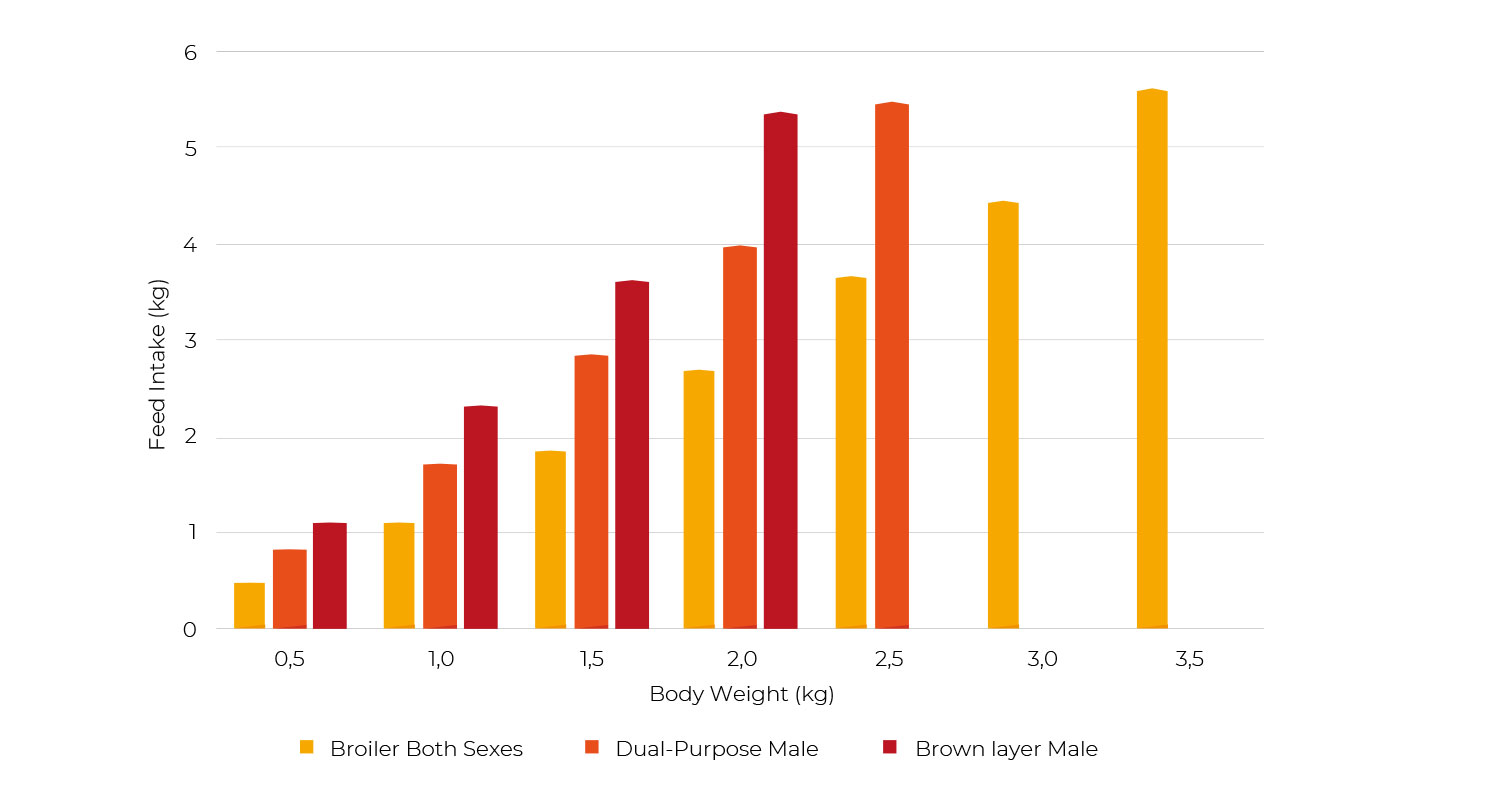
They represent a compromise between egg production and growth rate. Males of these lines have a higher growth rate than males of conventional layer hybrid lines (Figure 5), but neither are they competitive to commercial broilers, nor are their sisters competitive with females of specialized layer lines. Because of the extended duration of the growing period and the poor feed conversion rate the ecological footprints are inferior to specialized breeds (Damme et al., 2015). Gangnat et al. (2018) studied the willingness of consumers in Switzerland to pay more for meat and eggs from dual-purpose breeds. Using dual-purpose breeds was appreciated by the consumers as alternative to culling of chicks. The consumers were prepared to pay 13 % higher prices than the actual price for conventional chicken meat, but 34 % lower than for organic chickens. The willingness to pay for eggs from dual purpose hens was 29 % higher than the actual price for conventional eggs and 9% lower than for organic eggs. These results have been confirmed by a similar study in Germany (Reithmayer and Musshoff, 2019). Interestingly, the consumers expressed their preparedness to pay a considerably higher price for the meat of dual-purpose birds, provided that they are kept under free range conditions. In both studies the disposition to pay premium prices for the dual-purpose breeds was higher in consumers which usually buy organic products. It must be considered that both studies report the consumer’s attitude, which may not reflect the final decision when buying. Despite the willingness of part of the consumers to pay a higher price, the dual-purpose breed always remains a compromise preventing the widespread use of this option. The third option to avoid culling male chicks of layer lines is the identification of sex in the embryos either before or during incubation. Provided these methods are viable from the technical and economic point of view, the male eggs would not be incubated, or the male embryos would be destroyed in an early phase of development. According to Reithmayer and Musshoff (2019) German consumers generally accept in-ovo-sexing. This is in contrast with findings of Gremmen et al. (2018) in the Netherlands. Krautwald-Junghanns et al. (2018) reviewed the different methods to identify the embryo`s sex in the early incubation phase: Determination of the hormonal level (estrone sulphate) in the allantoic fluid after nine days of incubation, optical and imaging methods, such as reflectance spectroscopy and hyperspectral imaging, infrared spectroscopy, Raman spectroscopy, magnetic resonance imaging, molecular sexing assays and genetic engineering. Various methods have shown promising results in the laboratory. The most important problem is to reduce the time needed to test large numbers of hatching eggs with high accuracy and low impact on hatching rate. Currently only two companies are already offering chicks from in-ovo sex determination on the European market (Preisinger, 2020). On the one hand, the company Seleggt (http://www.seleggt.de\) using the endocrinological approach (hormonal level in the allantoic fluid) after nine days of incubation. On the other hand, the company AAT (https://www.agriat.com/) using the optical approach. This last procedure for sorting embryos of brown layers on the 13th day of incubation has been already developed for a high throughput and it can be used immediately as a bridging technology in the hatcheries under commercial conditions (Preisinger, 2020). Other projects continue their investigations to implement in-ovo sexing determination at an earlier age under commercial hatcheries conditions. Using genetic engineering to mark the sex chromosome with a fluorescent protein would allow the determination of the sex even before incubation. General reservations against Genetically Modified Organisms (GMO) in European countries suggest that this method may not be accepted, even if all technical problems can be solved. 
Conclusions
The transition from conventional cages towards alternative systems for laying hens in Europe and other industrialized countries is driven by welfare aspects. In the perception of the urban population non-cage systems are generally considered as animal friendly. These systems provide more freedom to move and a more variable and complex behaviour of the birds. The poultry keepers are facing particular problems related to the management of large groups, such as feather pecking and cannibalism, fear and smothering, nest utilization, use of perches and free-range areas. In order to recognize damaging or stereotyped behaviours in a flock on an early stage to minimize their negative effects, the birds need to be inspected frequently. Novel techniques, such as video-imaging may assist the observation of the flock. The traditional methods of molting layers using withdrawal of feed, water and light are not tolerated in European countries and in America any longer and need to be replaced by procedures which comply with the current welfare regulations. The use of molt may become obsolete through the selection for extended laying periods. Culling day-old males of layer lines has become an important welfare issue. Alternatives to this problem are raising the male chicks to slaughter weight, using dual-purpose lines and in-ovo-sexing. All methods are considered to be ethically better than culling the day-old chicks. The use of these methods in commercial poultry production is being investigated at present. Two approaches for in-ovo sex determination by the companies Seleggt and ATT have successfully passed the field trials and are offering chicks sexed by these methods to the market. The end of the day-old male culling can only be achieved if all available alternatives are used, if more powerful technologies are available for the hatcheries and if capacities are gradually increased to a larger scale.



